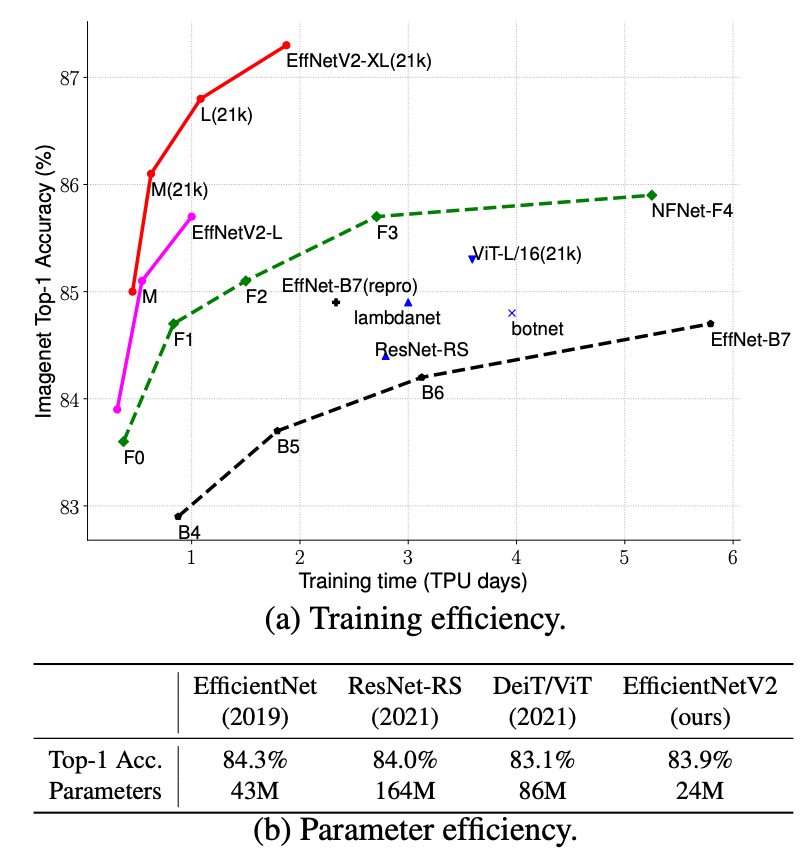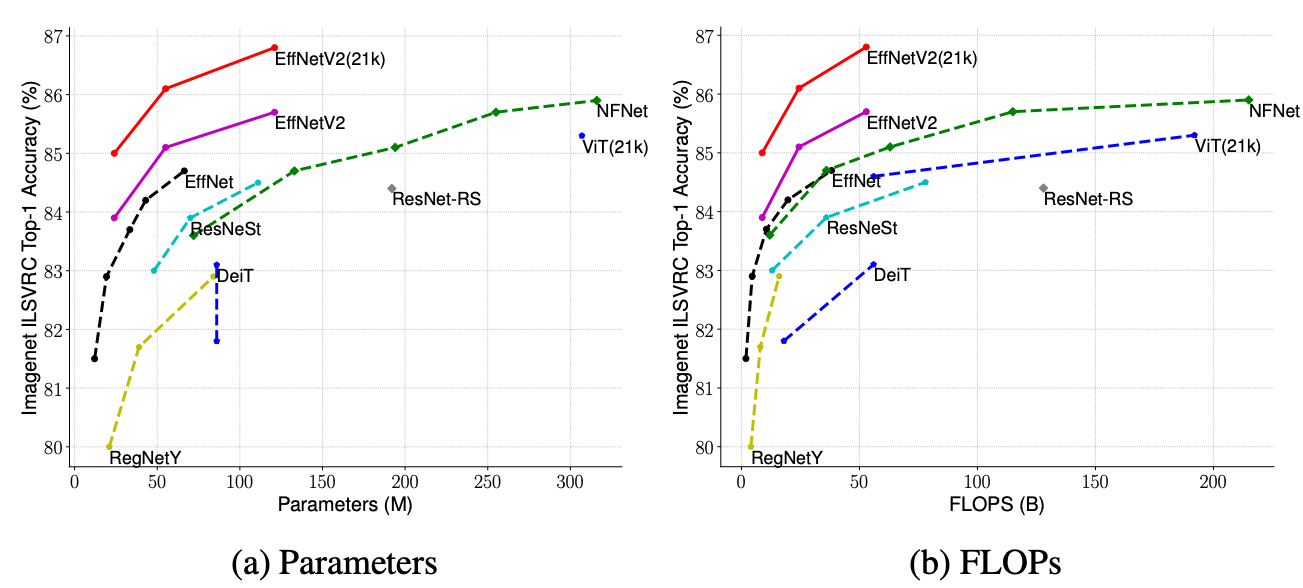- Jul19/2021: A list of updates
- May13/2021: Initial code release for EfficientNetV2 models: accepted to ICML'21.
EfficientNetV2 are a family of image classification models, which achieve better parameter efficiency and faster training speed than prior arts. Built upon EfficientNetV1, our EfficientNetV2 models use neural architecture search (NAS) to jointly optimize model size and training speed, and are scaled up in a way for faster training and inference speed.
Here are the comparison on parameters and flops:
We have provided a list of results and checkpoints as follows:
| ImageNet1K | Top1 Acc. | Params | FLOPs | Inference Latency | links |
|---|---|---|---|---|---|
| EffNetV2-S | 83.9% | 21.5M | 8.4B | V100/A100 | ckpt, tensorboard |
| EffNetV2-M | 85.2% | 54.1M | 24.7B | V100/A100 | ckpt, tensorboard |
| EffNetV2-L | 85.7% | 119.5M | 56.3B | V100/A100 | ckpt, tensorboard |
** Thanks NVIDIA for providing the inference latency: full TensorRT scripts and instructions are available here: link
Here are a list of ImageNet21K pretrained and finetuned models:
| ImageNet21K | Pretrained models | Finetuned ImageNet1K |
|---|---|---|
| EffNetV2-S | pretrain ckpt | top1=84.9%, ckpt, tensorboard |
| EffNetV2-M | pretrain ckpt | top1=86.2%, ckpt, tensorboard |
| EffNetV2-L | pretrain ckpt | top1=86.9%, ckpt, tensorboard |
| EffNetV2-XL | pretrain ckpt | top1=87.2%, ckpt, tensorboard |
For comparison with EfficientNetV1, we have also provided a few smaller V2 models using the same scaling and preprocessing as V1:
| ImageNet1K | Top1 Acc. | Params | FLOPs | links |
|---|---|---|---|---|
| EffNetV2-B0 | 78.7% | 7.1M | 0.72B | ckpt, tensorboard |
| EffNetV2-B1 | 79.8% | 8.1M | 1.2B | ckpt, tensorboard |
| EffNetV2-B2 | 80.5% | 10.1M | 1.7B | ckpt, tensorboard |
| EffNetV2-B3 | 82.1% | 14.4M | 3.0B | ckpt, tensorboard |
Here are the ImageNet21k checkpoints and finetuned models for B0-B3:
- EffNetV2-B0: ImageNet21k, ImageNet21k-ft1k
- EffNetV2-B1: ImageNet21k, ImageNet21k-ft1k
- EffNetV2-B2: ImageNet21k, ImageNet21k-ft1k
- EffNetV2-B3: ImageNet21k, ImageNet21k-ft1k
Train on ImageNet1k from scratch:
python main.py --mode=train --model_name=efficientnetv2-s --dataset_cfg=imagenet --model_dir=$DIR
Train on ImageNet21k from scratch:
python main.py --mode=train --model_name=efficientnetv2-s --dataset_cfg=imagenet21k --model_dir=$DIR
Finetune on ImageNet from scratch:
python main.py --mode=train --model_name=efficientnetv2-s --dataset_cfg=imagenetFt --model_dir=$DIR --hparam_str="train.ft_init_ckpt=$PRETRAIN_CKPT_PATH"
Finetune on CIFAR10:
python main.py --mode=train --model_name=efficientnetv2-s --dataset_cfg=cifar10Ft --model_dir=$DIR --hparam_str="train.ft_init_ckpt=$PRETRAIN_CKPT_PATH"
You can directly use this code to build a model like this:
mode = tf.keras.models.Sequential([
tf.keras.layers.InputLayer(input_shape=[224, 224, 3]),
effnetv2_model.get_model('efficientnetv2-b0', include_top=False),
tf.keras.layers.Dropout(rate=0.2),
tf.keras.layers.Dense(4, activation='softmax'),
])
Or you can also load them from tfhub:
hub_url = 'gs://cloud-tpu-checkpoints/efficientnet/v2/hub/efficientnetv2-b0/feature-vector'
model = tf.keras.Sequential([
tf.keras.layers.InputLayer(input_shape=[224, 224, 3]),
hub.KerasLayer(hub_url, trainable=do_fine_tuning),
tf.keras.layers.Dropout(rate=0.2),
tf.keras.layers.Dense(4, activation='softmax'),
])
python infer.py --model_name=efficientnetv2-m --model_dir=$MODEL_DIR
A simple example to use EfficientNetV2 model:
# build keras model
model = effnetv2_model.EffNetV2Model('efficientnetv2-s')
# run keras model with inputs [batch, heigh, width, channels]
endpoints = model(inputs)
# endpoints[0] is the logits, endpoints[i] is the reduction_level_i
Currently, supported model_name includes: efficientnetv2-s, efficientnetv2-m, efficientnetv2-l, efficientnetv2-b0, efficientnetv2-b1, efficientnetv2-b2, efficientnetv2-b3. We also support all EfficientNetV1 models including: efficientnet-b0/b1/b2/b3/b4/b5/b6/b7/b8/l2


